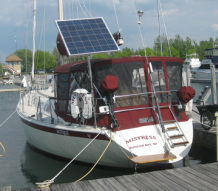 140 Watt Poly-crystalline Solar Panel 140 Watt Poly-crystalline Solar Panel In an earlier blog entry dated 8/10/2011 I documented the performance of our 130 watt mono-crystalline solar panel on a 22 day cruise in the upper Great Lakes. In an August 2012 blog entry I documented the performance of our 140 watt poly-crystalline solar panel. This year I documented the performance of our 160 watt mono-crystalline solar panel on the same boat under similar conditions. The only variables were the weather and the running of the engine when moving from anchorage to anchorage (wind was on our nose quite often this summer). The number of days of each cruise varied so I an presenting average performance based on four weather conditions; sunny, mostly sunny, mostly cloudy and cloudy. Test conditions:
Test Results: Definition: amp hour – amps produced or consumed in one hour Average amp hours per day produced under various conditions: 130 Watt, mono 140 Watt, poly 160 Watt, mono Overall average output per day 54 amp hours 53 amp hours 48 amp hours Note: 160W had only 5 sunny days, 140W had 10 sunny days and 130W had 8 sunny days Sunny days 71 69 71 Mostly sunny days 51 50 50 Mostly cloudy days 46 35 37 Cloudy days 24 32 28 Avg. Output on days at anchor 62 62 61 Avg. Output when engine was used 35 43 44 (difference partially because 130W was often disconnected often when engine was used. Not so for 140W and 160W) Min amp hrs for a day 16 27 28 Max amps output 10.5 amps 10.5 amps 11.5 amps Interpreting the Results: Each solar panel performed about as expected. The average daily output was less for the 160 watt panel but it had half as many sunny days and comparable mostly sunny days. The 130 watt mono panel provided a slightly higher average output on sunny days and the 140 watt poly panel provided a higher average output on cloudy days. The max output of the 160 watt panel was an amp higher that the others. My sense was that the poly-crystalline panel was less sensitive to shading from the rigging but this is difficult to document. On sunny days, both solar panels often performed above their sticker rating of 130, 140 and 160 watts by as much as 50 watts (9.5 amps at 21 volts is 189 watts) . I believe this is due to the high quality of silicone crystals used. Observations: All three solar panels generally met our power needs for the duration of the cruises. We occasionally ran a small deficit of amp hours during an extended anchorage when cloudy but never needed to use the engine alternator to charge the battery banks except when motoring from place to place. On days when the engine was used we often had an excess of power generation from the 75 amp alternator and the solar panel. Choosing the right type of solar panel: Based on the performance data, each solar panel will perform adequately under most conditions. The 130 watt and 160 watt mono-crystalline solar panels are an excellent choice for boats in mostly sunny areas with little possibility of shading from the rigging. The 140 watt poly-crystalline solar panel is an excellent choice for areas with more partly cloudy and cloudy days and on boats where there is some shading from the rigging.
1 Comment
|
Categories
All
AuthorThomas Trimmer has been cruising with his Ericson 38 sailboat on the Great Lakes for over 20 years. He has pioneered the use of solar energy for wilderness cruising. He is continually designing and building equipment to simplify and enhance the cruising experience. Archives
April 2024
|
Efficiently Powering Your Vessel/Van. Call/email/chat any time, we're happy to help you work through designing your solar system.
Home Page Solar Panels Mounting Kits Product Page Marine Solar Systems Gallery of Installations Customer Comments Contact Us
Call 248 705-8337 or email [email protected]
Article On How To Size Your Solar Panels For Your Boat
Customer Reviews Return Policy Privacy Policy Shipping Times/Rates
Home Page Solar Panels Mounting Kits Product Page Marine Solar Systems Gallery of Installations Customer Comments Contact Us
Call 248 705-8337 or email [email protected]
Article On How To Size Your Solar Panels For Your Boat
Customer Reviews Return Policy Privacy Policy Shipping Times/Rates

 RSS Feed
RSS Feed